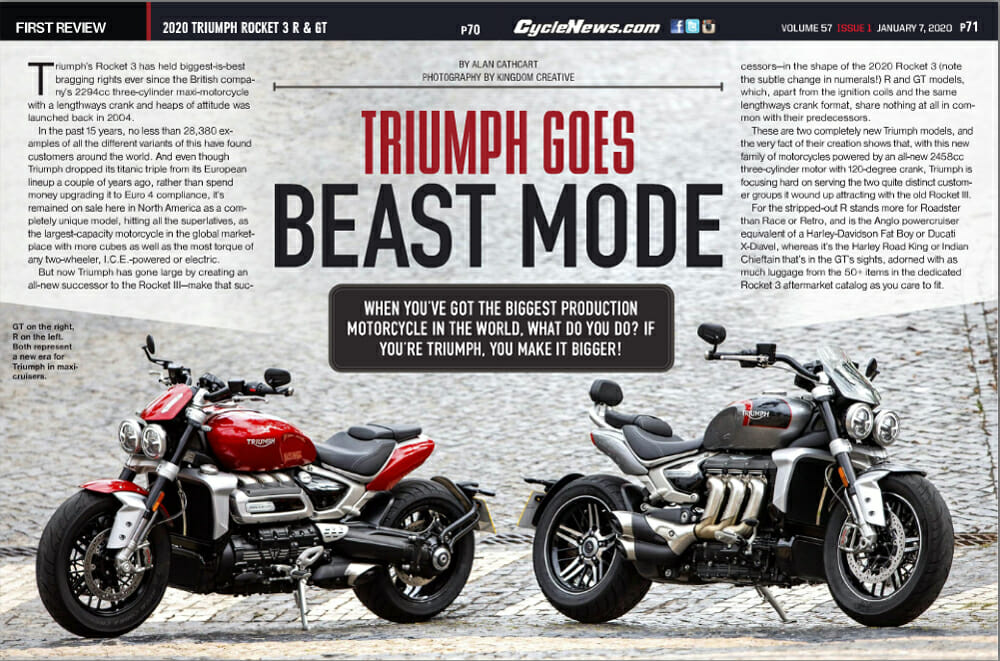Alan Cathcart | January 11, 2020
When you’ve got the biggest production motorcycle in the world, what do you do? If you’re Triumph, you make it bigger!
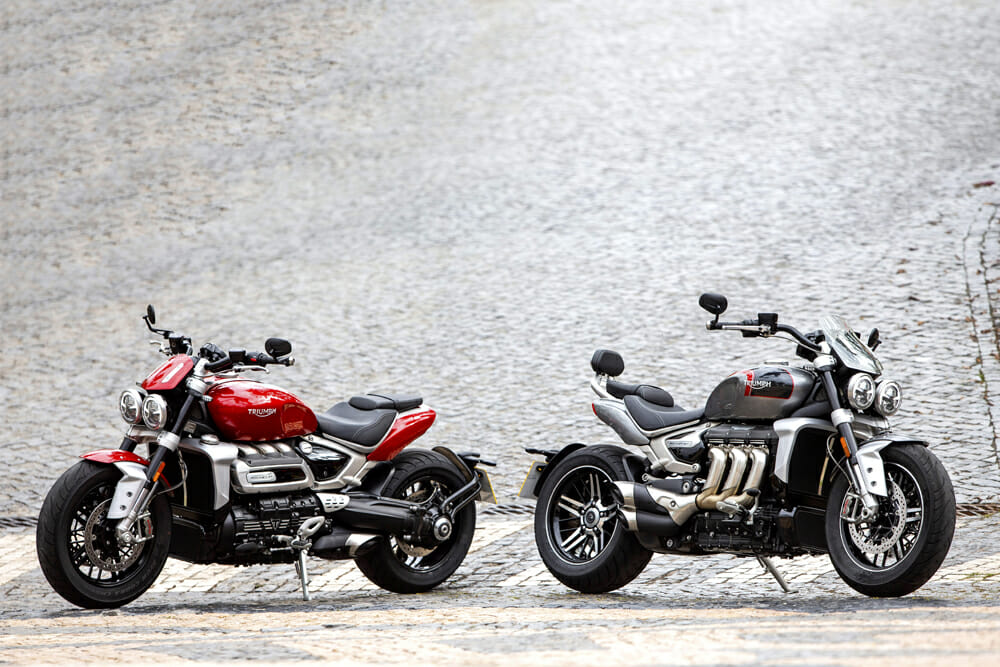 GT on the right, R on the left. Both represent a new era for Triumph in maxi-cruisers.
GT on the right, R on the left. Both represent a new era for Triumph in maxi-cruisers.
Photography by Kingdom Creative
Triumph’s Rocket 3 has held biggest-is-best bragging rights ever since the British company’s 2294cc three-cylinder maxi-motorcycle with a lengthways crank and heaps of attitude was launched back in 2004.
In the past 15 years, no less than 28,380 examples of all the different variants of this have found customers around the world. And even though Triumph dropped its titanic triple from its European lineup a couple of years ago, rather than spend money upgrading it to Euro 4 compliance, it’s remained on sale here in North America as a completely unique model, hitting all the superlatives, as the largest-capacity motorcycle in the global marketplace with more cubes as well as the most torque of any two-wheeler, I.C.E.-powered or electric.
But now Triumph has gone large by creating an all-new successor to the Rocket III—make that successors—in the shape of the 2020 Rocket 3 (note the subtle change in numerals!) R and GT models, which, apart from the ignition coils and the same lengthways crank format, share nothing at all in common with their predecessors.
These are two completely new Triumph models, and the very fact of their creation shows that, with this new family of motorcycles powered by an all-new 2458cc three-cylinder motor with 120-degree crank, Triumph is focusing hard on serving the two quite distinct customer groups it wound up attracting with the old Rocket III.
For the stripped-out R stands more for Roadster than Race or Retro, and is the Anglo powercruiser equivalent of a Harley-Davidson Fat Boy or Ducati X-Diavel, whereas it’s the Harley Road King or Indian Chieftain that’s in the GT’s sights, adorned with as much luggage from the 50+ items in the dedicated Rocket 3 aftermarket catalog as you care to fit.
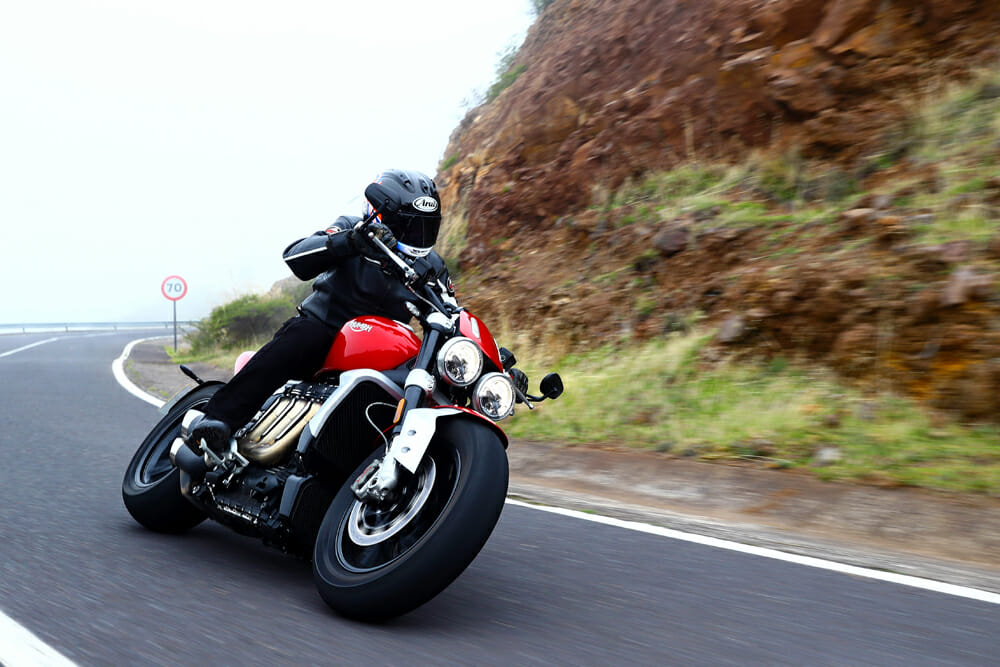 Given the 641 pounds dry weight, it’s genuinely surprising how hard you can hustle the Rocket 3 R around.
Given the 641 pounds dry weight, it’s genuinely surprising how hard you can hustle the Rocket 3 R around.
Testing the 2020 Triumph Rocket 3 R & GT
Riding the pair of new bikes for half a day each along a 125-mile route winding around the island of Tenerife, underlined the new bike’s effectiveness. Whereas the old Rocket III engine’s torque fell away quite sharply above 3000 revs, this new cubed-up version is so much punchier all the way through the rev range that you can ride it any way you like. If you fancy chilling out, just leave it in a higher gear and surf that massive wave of grunt—it will literally pull from the 1500-rpm idle speed in top gear all the way to the rev-limiter with zero transmission snatch—and surprisingly smartly, too, thanks to the new motor’s fatter, flatter midrange power delivery.
But if you fancy being a little sportier, use the sweet-action gearshift to flick through the six-speed gearbox, though if you rev it out beyond 5000 rpm you must use the clutch to make clean upwards shifts—below that, it’s fine, though.
However, adding an extra ratio to the new transmission is completely unnecessary, and only done for marketing reasons—the five-speed gearbox in the old Rocket III was already one too many. More cubes, more power and more torque do not dictate the need for an extra gear ratio!
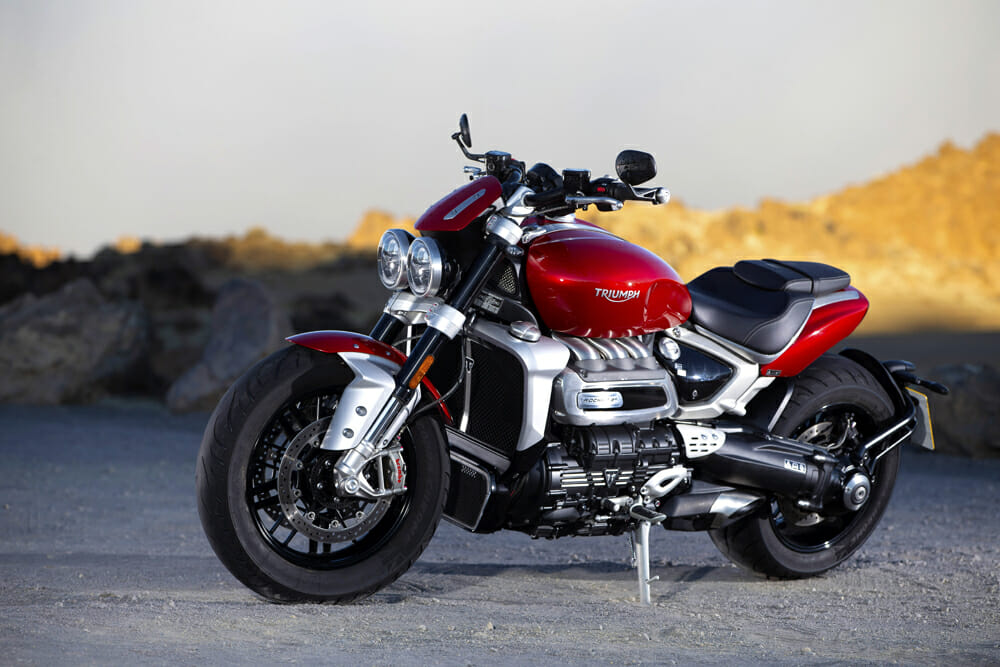 Check out the massive shaft drive on the R!
Check out the massive shaft drive on the R!
Despite their meaty weight, the Rocket 3 duo will not exactly rocket forward, but they’ll certainly build momentum in a very decisive yet controllable way. There’s an optional two-way powershifter in the Triumph catalog, and I’d say this’d be a must-have fitment to complete the ease with which the Rocket 3 can be ridden, either model, too.
But that huge hit of torque, which makes a Harley LiveWire’s 117Nm seem practically wimpish, though a Zero SR/F’s 190Nm is getting there in a bike weighing ‘just’ 485 pounds all up—is brilliantly controlled in any of the RBW throttle’s four different riding modes: Road, Sport, Rain (with a 100 bhp power cap) and Rider-configured. The Keihin ECU restricts output in the lower gears in all modes, and the bike is speed-limited electronically to 138 mph, just as the Thunderbird cruiser was to 130 mph.
This means that opening the throttle at practically any revs is the gateway to an almost irresistible and seemingly implausible level of acceleration for such a hefty piece of hardware—yet this is delivered in an almost understated way. It’s totally effortless, with just a nice little burble from the 3-1-3 exhaust, which features two stylized slash-cut exits in front of the rear wheel on the right, and a single one on the left. But then when you back off the throttle to slow for a turn, the exhausts pop back gently on the overrun, which adds a bit of character to such a smooth-running motor. And smooth it is, indeed—there’s absolutely no vibration even if you rev it out to the hard-action limiter, so those new counterbalancers do their job perfectly. Cruising along at 100 mph on the GT with the engine turning over at just 3800 rpm, was practically relaxing! Despite its telephone-number torque and power figures, this is a true gentle giant of the two-wheeled marketplace, delivering those extreme engine stats in a controllable yet exciting way that’s both reassuring and thrilling at the same time. You don’t need to be Scott Redding to ride this motorcycle hard.
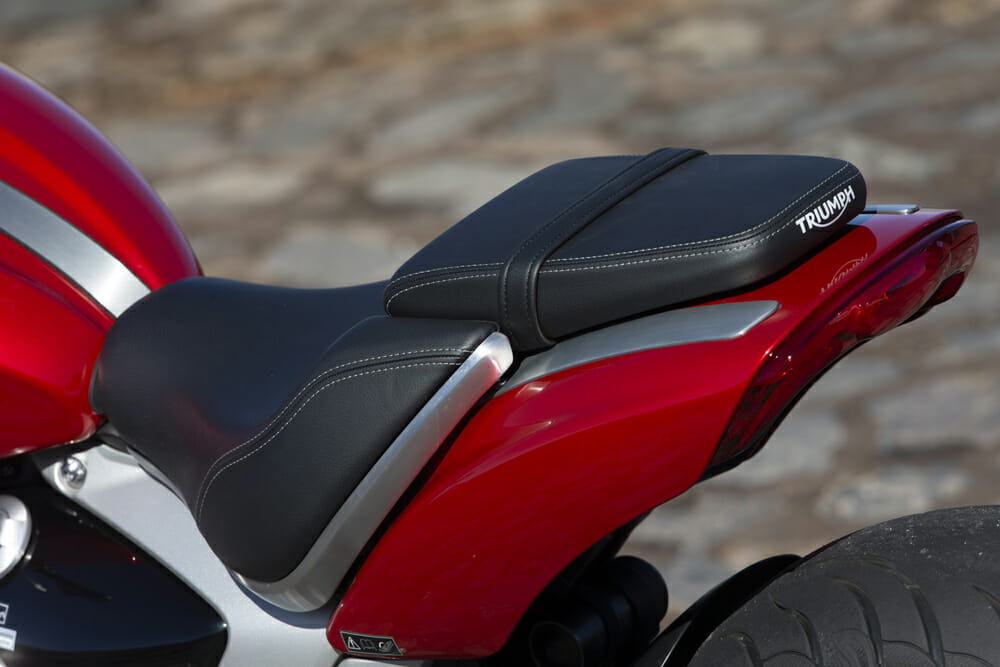 Gone is the droopy tail of the old model. In its place sits a much sharper, slimmer unit.
Gone is the droopy tail of the old model. In its place sits a much sharper, slimmer unit.
You also don’t need to be a Schwarzenegger to hustle the Rocket 3 through the twists and turns of the Tenerife lava fields. One reason is that at 641 pounds dry for the R-model, the new bike is a massive 88.1 pounds lighter than the old one, thanks not only to the lighter motor, but also the bolted-up all-aluminum frame comprising six different castings and forgings together weighing 28 pounds, half as much as before. With that massive engine playing its part as a fully integrated component, the result is an extremely stiff chassis package despite its sheer length. The R especially is a marvelous piece of packaging, an ultra-long wheelbase motorcycle with rangy steering geometry that seems a much smaller bike in the way it steers – though on both models you’re very much aware at all times just what a massive hunk of metal you happen to be riding, without it being at all daunting, thanks to both bikes feeling so cleverly balanced.
Triumph doesn’t quote curb weights, but with a full 4.7-gallon tank of fuel as well as coolant and oil that must mean the R-model will weigh upwards of 705 pounds—but on the highway you honestly never get the feeling that it’s such a massive hunk of metal. You do need to be careful if you pull off to the side and start heading over bumpy terrain en route to your parking place—stick both feet out ready to catch it if necessary, because that’s the only time you’re aware of its size and especially weight, probably thanks to the short 4.2 inches travel of the fully adjustable Showa rear shock, with remote preload adjuster for carrying a passenger or luggage.
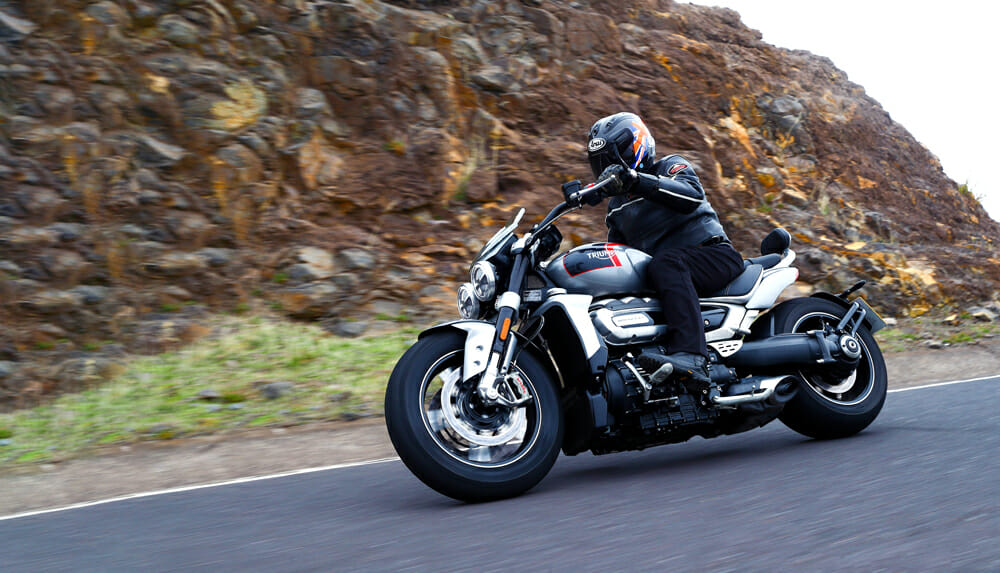 A little more weight goes with the GT, but it’s unlikely you’ll notice a small increase on a bike weighing nearly 650 pounds dry.
A little more weight goes with the GT, but it’s unlikely you’ll notice a small increase on a bike weighing nearly 650 pounds dry.
Hauling up the 2020 Triumph Rocket 3 R & GT
In normal use both versions of the Rocket 3 were unexpectedly capable in terms of stopping, steering and overall handling, and vastly more so than the old bike, thanks partly to the monster Avon Cobra Chrome tires fitted to both versions, with a 150/80-17-inch front matched to a 240/50-18-inch rear. Specially developed for the Rocket 3, these gave improbably good grip—especially the rear one when asked to put a good proportion of all that torque to the tarmac leaned over exiting a turn. The 47mm Showa BPF cartridge fork is adjustable for compression and rebound damping, and delivers 4.7 inches of wheel travel, though I’m sure there’s further suspension available via the fat front tire’s sidewalls. The fork sits at a 27.9° rake with a massive 5.3 inches of trail, despite which neither version was anything like as heavy-steering as I expected, even with the lengthy 66-inch wheelbase. For whatever reason the GT was the surprise packet, being noticeably easier to flick from side to side thanks to the wider, pulled-back handlebar. Normally, I don’t much care for feet-forward riding, but I was actually sorry when I had to swap bikes, having soon learned to tuck my heels in with the footrests nestling in my instep if I didn’t want them chamfered down! Ground clearance was pretty good on both bikes, and the grippy tires certainly give heaps of confidence in riding these bikes hard.
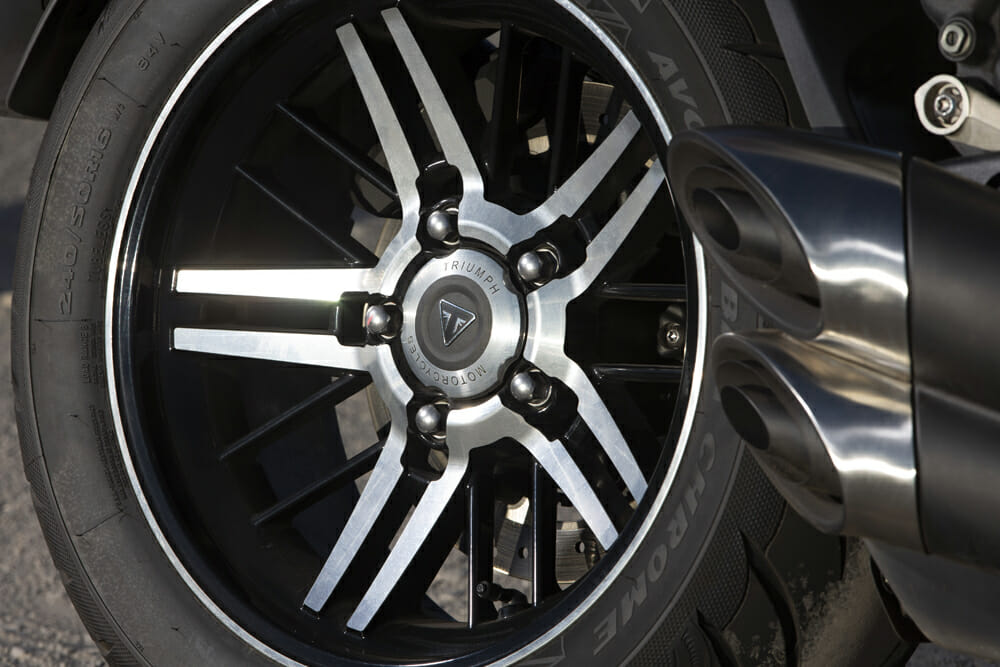 Gotta love a little chrome on the GT rear wheel. That’s a 240-section tire, by the way.
Gotta love a little chrome on the GT rear wheel. That’s a 240-section tire, by the way.
Do that, and you’ll need the best brakes in the business to stop a bike this heavy, and fast—and that’s what Triumph has equipped the Rocket 3 with. The last time I rode a motorcycle with the new Triumph’s Brembo Stylema four-pad calipers gripping the 320mm twin front discs was the Ducati Panigale V4 R Superbike homologation special—so that tells you the level the British firm is batting at here. The rear 300mm disc is even matched to a Brembo M4 32.4 Monobloc four-piston caliper, the same brake fitted up front to factory Ducati Superbikes until last year, here used at the rear! What’s more, not only are these brakes fitted with Continental’s Cornering ABS operated via its six-axis IMU which also delivers switchable TC, but Triumph has introduced electronically variable linked braking on the Rocket 3, whereby when you squeeze the front brake lever, the ECU decides what proportion of braking power should be applied on the rear, as well. This is primarily determined via speed, weight transfer and lean angle, leaving you free if you wish to add extra bite at the back by working the foot lever, which doesn’t also operate the front.
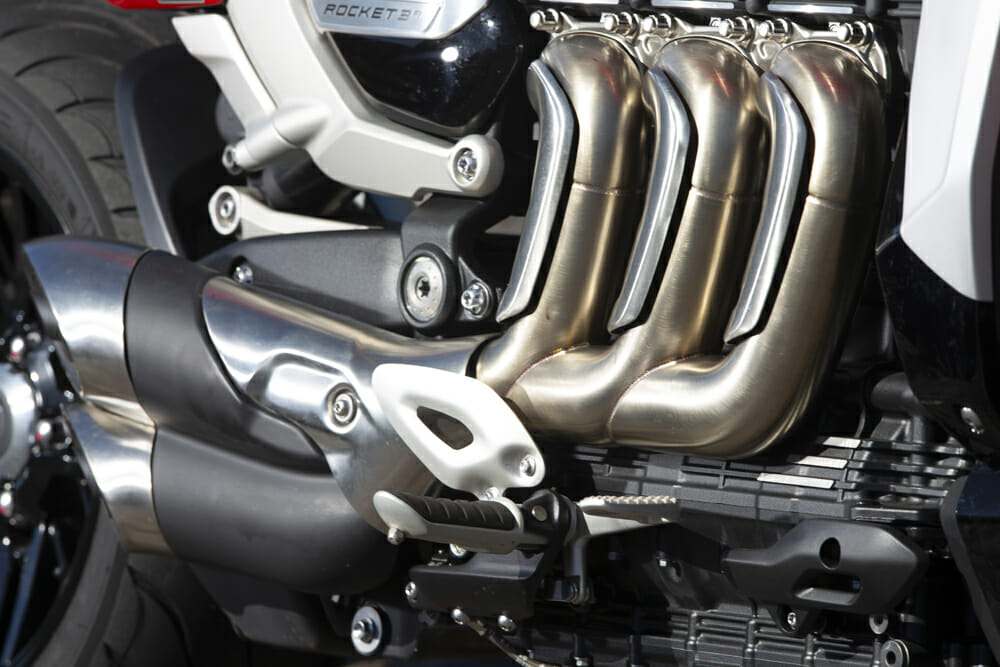 There’s 163 pounds of arm-wrenching torque hiding in that motor.
There’s 163 pounds of arm-wrenching torque hiding in that motor.
I can honestly say that I really could feel the rear brake being operated via the electronics even though I was only squeezing the front brake lever—and this actually is beneficial to the bike’s deportment in turns, because it sets up a counter to the massive weight transfer on such a heavy bike when you squeeze hard on the front brake lever only. Lots of MotoGP and WSBK riders use the rear brake to set up the bike for a turn like this, and it seems to me that’s what the Rocket 3 is programmed to do—electronically.
The Rocket 3 duo come with a host of high-tech features as standard, including keyless ignition and steering lock, a hill-hold function accessed by squeezing the brakes while stationary, cruise control, a USB port in a padded receptacle so you can charge your phone on the go without it getting shaken around, full LED lighting, heated grips (standard on the GT, optional on the R), a 12v socket for accessories like heated clothing etc., and cabling and wiring tucked away inside the handlebar for a clean look. The passenger’s fold-out footpegs look great, though are maybe a little on the short side. The round TFT dash is sourced from the 1200 Scrambler, but still doesn’t have the Bluetooth connectivity and smartphone app that was promised a year ago, and was absent from the test bikes at Tenerife. This will allow the rider to answer the phone, plot a route via turn-by-turn satnav directions, control music or operate a GoPro camera via the joystick on the left ’bar. No word yet when this will finally become operational—but it’s coming sometime! Besides these, your £20K [$26,150] price ticket also includes a high level of finish: the bikes are now 100% built in Thailand, and having visited the factory there and been impressed by the fervent attention to QC on the part of both Asian and British staff, I’m not surprised how high the build quality of both models is.
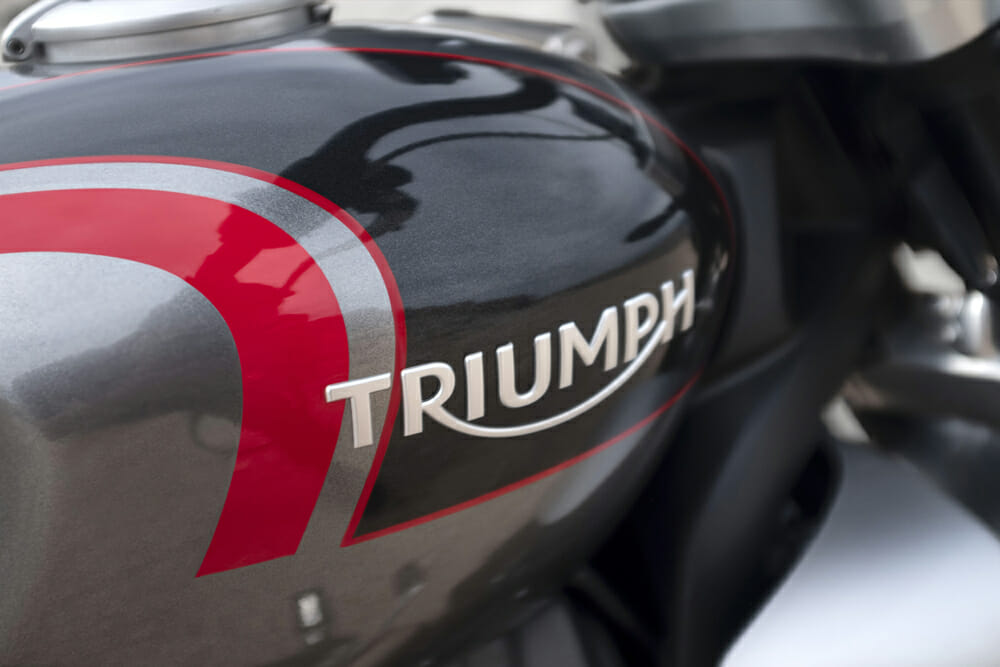 Surprisingly, the tank size has been reduced rather dramatically from 6.3 gallons to 4.7 gallons despite the capacity increase.
Surprisingly, the tank size has been reduced rather dramatically from 6.3 gallons to 4.7 gallons despite the capacity increase.
One area where Triumph has downsized on a bike in which it’s otherwise gone large is the fuel tank, which has been reduced to just 4.7 gal from the old Rocket III Roadster’s 6.3 gal. This has to fuel a very thirsty motor, especially when it’s used in something approaching anger—like on a press launch!
That apart, the new Rocket 3 duo are a tour de force for Triumph—a pair of musclebikes that handle, which are likely to appeal to lots of customers who wouldn’t otherwise buy a cruiser. Think of them both—the R, especially—as a Speed Triple on steroids, and you’ll get the picture. No doubt about it, less can be more, sometimes, but more of everything is pretty hard to beat!
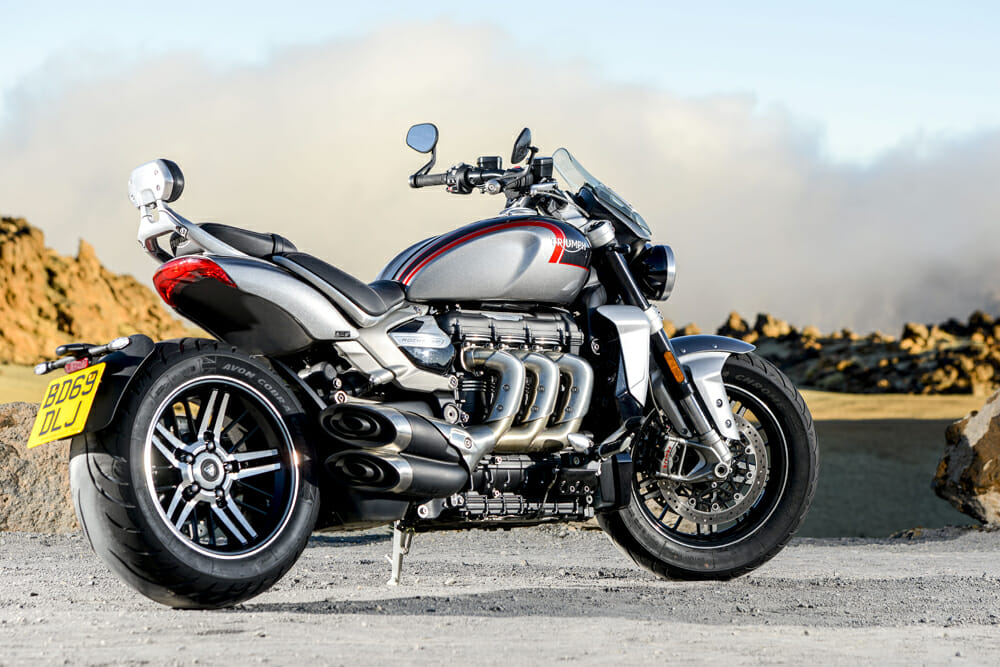 Forward sitting pegs and a lower seat characterize the riding position on the GT.
Forward sitting pegs and a lower seat characterize the riding position on the GT.
2020 Triumph Rocket 3 R & GT—Same But Different
Though sharing a common platform to the extent that all components are interchangeable between the two, the R and GT are very different in both appearance and riding experience. The roadster R-model weighing 641 pounds dry has a taller 30.4-inch tall seat with separate minimalist pillion pad, mid-mounted footrests and a flatter one-piece handlebar, which encourages a slightly more aggressive leant-forward riding stance. The 648-pound GT is what it says on the label, a grand tourer with feet-forward footpegs, a lower 29.5 in. seat, a pulled-back handlebar behind a reasonably effective flyscreen, and an adjustable backrest behind a more accommodating passenger seat. Each Rocket 3 model offers a range of adjustable ergos in pursuit of rider comfort, so the R-model’s footrests can be raised or lowered 0.59 in., while the GT offers three horizontal footrest choices over a 50mm span. But the engine and chassis platforms are common to both.
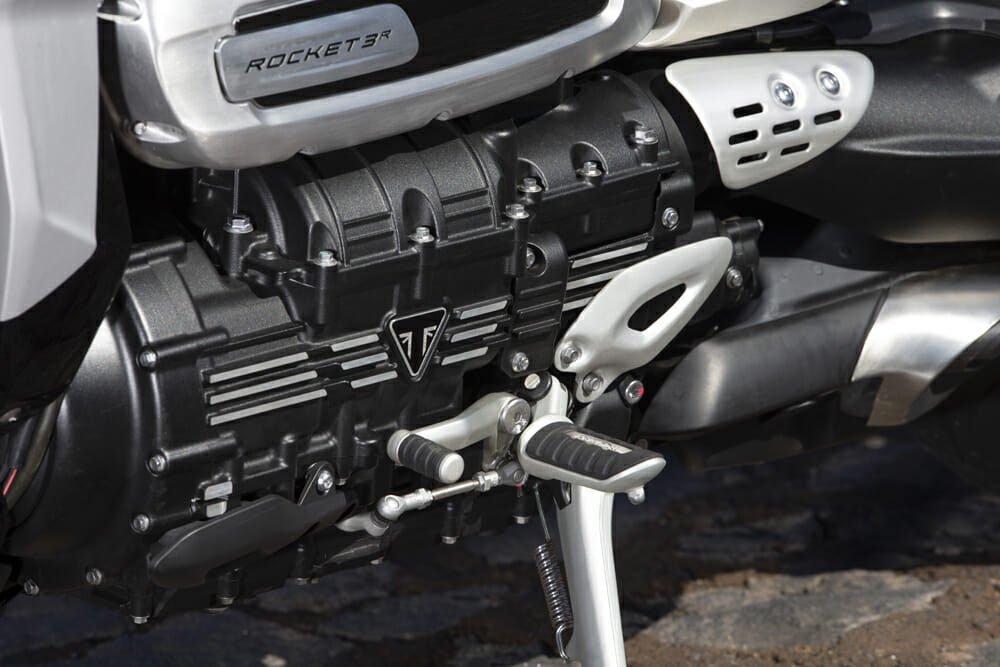
The Rocket 3’s all-new 2458cc Euro 5-compliant motor is actually a short-stroke design measuring 110.2 mm x 85.9 mm, versus the 101.6 x 94.3 mm format of the outgoing 2294cc engine. This allows Triumph’s R&D team led by the firm’s Chief Engineer, Stuart Wood (whose favorite ride-to-work bike is a 180 bhp Rocket III hot rod he concocted himself at home!) to use shorter conrods to reduce the height of the motor. This also allows a heady 7000 rpm redline, with peak power of 165 bhp delivered at 6,000 rpm—a serious 14 percent hike from the old bike’s 146 bhp. More to the point, though, is that the larger capacity new engine weighs a massive 39.6 pounds less than the old, smaller one, 24.2 pounds of that thanks to a new crankcase assembly (Triumph didn’t have the capability to make its own crankcases for the Rocket III, but it does now for its new-gen version), with the rest down to a new dry sump lubrication system with an integral oil tank, and new balancer shafts. Plus, while peak torque is the same as before at 221Nm (163 lb-ft), this is delivered at 4,000 rpm – but there’s a vastly wider spread of grunt all the way through the revband, with 95 percent of available torque delivered over 60 percent of the revband, says Stuart Wood. “Between 2500 and 5,500 rpm, we have more than 200Nm (147 lb-ft) constantly available,” he states. “The new Rocket 3 delivers 70 percent more torque than its closest rival. Our aim was to produce an even more effortless and more refined power unit, thanks to the extra capacity, and revised internals.” CN
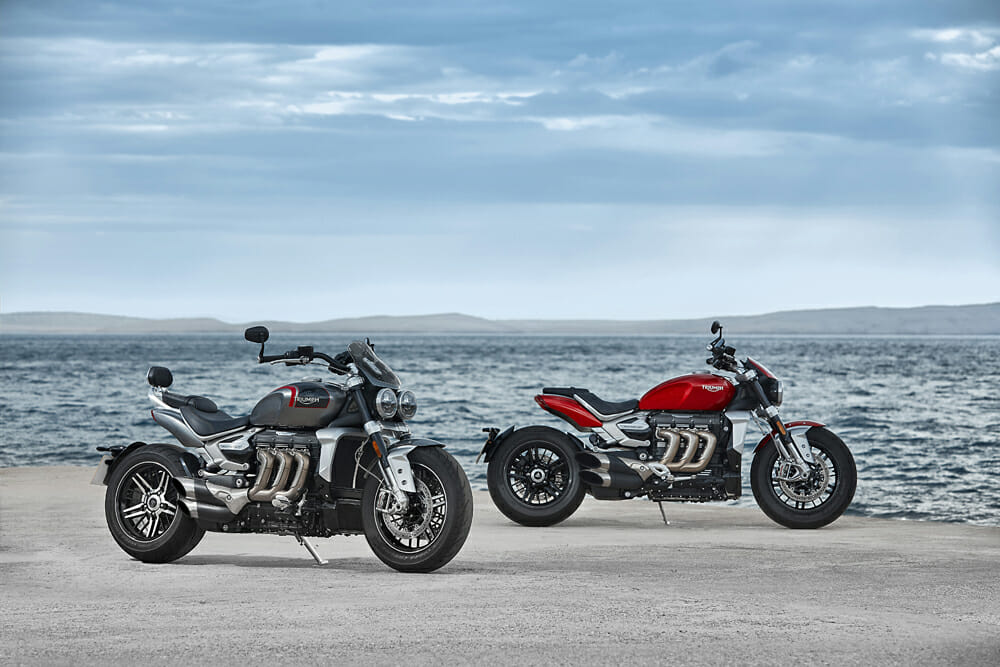
2020 Triumph Rocket 3 R & GT Specifications
| MSRP |
$21,900 (GT $22,600) |
| Engine Type |
Inline 3-cylinder, water-cooled, DOHC |
| Capacity |
2458cc |
| Bore/Stroke |
110.2mm x 85.9mm |
| Maximum Power |
165 bhp @ 6,000 rpm |
| Maximum Torque |
163 lb-ft @ 4,000 rpm |
| Fuel system |
Ride-by-wire, fuel injected |
| Exhaust |
Stainless 3-into-1 headers with 3 exit silencer / CAT box |
| Final drive |
Shaft, bevel box |
| Clutch |
Hydraulic, torque-assist |
| Gearbox |
6 speed |
| Frame |
Full aluminum frame |
| Instruments |
TFT multi-functional instrument pack with digital speedometer, trip computer, digital tachometer, gear-position indicator, fuel gauge, service indicator, ambient temperature, clock and rider modes (Rain/Road/Sport/Rider-configurable) – |
|
Triumph TFT Connectivity System can be added with accessory fitted Bluetooth module |
| Swingarm |
Single-sided, cast aluminum |
| Front Wheel |
17 x 3.5 in. cast aluminum |
| Rear Wheel |
16 x 7.5 in. cast aluminum |
| Front Tire |
150/80 R17 V |
| Rear Tire |
240/50 R16 V |
| Front Suspension |
Showa 47mm upside-down 1+1 cartridge front forks, compression and rebound adjuster. 4.7 in. travel |
| Rear Suspension |
Fully adjustable Showa piggyback reservoir RSU with remote hydraulic preload adjuster, 4.2-in. rear wheel travel. |
| Front Brake |
2 320mm discs, Brembo M4.30 Stylema 4-piston radial monobloc calipers, cornering ABS |
| Rear Brake |
1 300mm disc, Brembo M4.32 4-piston monobloc caliper, Cornering ABS |
| Seat Height |
30.4 in. (GT 29.5 in.) |
| Rake |
27.9º |
| Trail |
5.3 inches |
| Wheelbase |
66.0 in. |
| Dry Weight |
641 lbs. (GT 648 lbs.) |
| Fuel Tank Capacity |
4.7 gal. |
